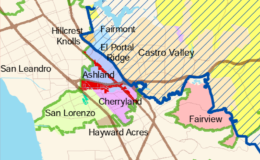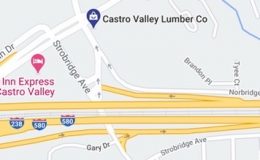On Monday night, a capacity crowd jammed into the Castro Valley Library to attend the latest Castro Valley Municipal Advisory Council (MAC) meeting.
The “Public Comment” section was very diverse. Topics covered the entire Valley spectrum and included the ongoing garbage situation in the Canyonlands, as well as a downed tree in Baywood ignored by the County for over a year. The ever popular topic of cell phone towers was broached, as well as the potential sale by CalTrans of a Native American burial site near Douglas Morrison Theater. By far, the most crowd reaction came from the topic of a potential conflict of interest by the MAC Chair Marc Crawford regarding the matter of a new housing development off of Proctor Road.
You can hear an audio recording of the public comment period by clicking here.
After that, the topic shifted to a proposal to upgrade an existing Cell Tower on the property of Pete’s Hardware. The MAC has stated that they would like the site to be “camouflaged” but the company, Crown Castle (servicing a Verizon facility,) refused saying that their Site Development Review (SDR) issued in 1991 had no expiration date, and did not require camouflage. Debate ensued as to whether the site was operating under that same SDR, or a later Conditional Use Permit (CUP) which would require eventual renewal and review by the MAC. County staff could not answer definitively, so the item was continued -pending review by County Counsel.
The meeting then moved on to review a proposed development on the so called “Proctor Court” subdivision designed to occupy the undeveloped hillside between Proctor and Almond Roads. This is the third proposal brought before the MAC to develop this hillside. Due to public and MAC comments, the project has been shrunk to 18 houses on a private road. MAC Chair Crawford had recused himself from the topic, so Vice Chair Miraglia oversaw 24 concerned citizens who made comments on the new proposal. A new developer, Braddock and Logan, gave a very informative Power Point presentation on the project. The latest iteration includes fewer home sites, elimination of a proposed cul-de-sac, and a different approach to waste water disposition.
Public comments (of which there were many,) focused on the potential public safety and infrastructure impacts on the site to enable the new homes. All proposed home sites include an “oversized” two car garage and a two car driveway, but on-street parking is limited to 18 spots -one per home. The developer noted that the new development would be under an HOA with a CC&R that would require the maintenance of two parkable spaces in each garage for resident use to mitigate on street parking issues, but many in the crowd found this far from adequate.
Many commentators, including one current Oakland Firefighter, noted that the proposed street and parking configuration would make it very difficult to fight a fire with the largest of the current Alameda County Fire Department vehicles. Many parallels were shown between this neighborhood and the ones devastated by the Oakland Hills Fire of 1991.
One commenter noted that no consideration had been given to the increased impact on Castro Valley Schools. She noted that all Elementary Schools in Castro Valley were currently completely full in grades K-3 and could accept no more students. Adding a development of 18 units with no mitigation would not benefit the town as a whole.
Additionally, concerns were raised about the potential impact on rare local native species such as the Burrowing Owl, and the Alameda Whip Snake.
Overall, many people said that they were opposed to the scope (i.e. number of homes) in this new proposal, and not the idea of a housing development in general. This has been a theme for all development proposals at this site so far.
After comments were heard, the MAC continued a decision until October. They would like to see more environmental impact report information, confirmation from CVUSD about the mitigation from increased enrollment. The MAC would also want the developer to explore expanded parking and the feasibility of a smaller scale project, and verify with EBMUD that there is ample water pressure in the neighborhood before & after development.
This is just another example of why we have a MAC in Castro Valley. If you come and talk about what concerns you, you will be heard. The MAC exists solely to transmit the desires of the community to the Board of Supervisors. Come on down! The next meeting will be on Monday , September 22nd. Come down to the Library and be a part of the solution!
Related


